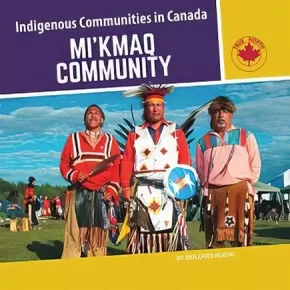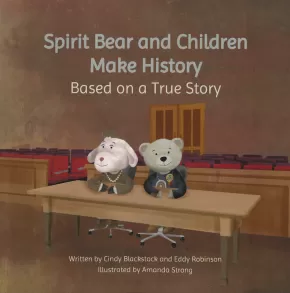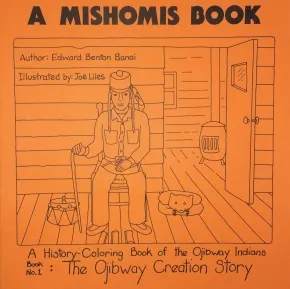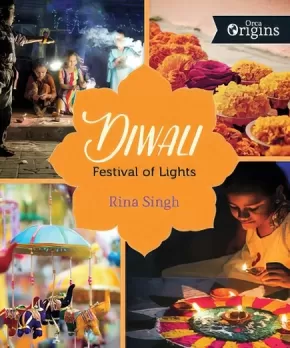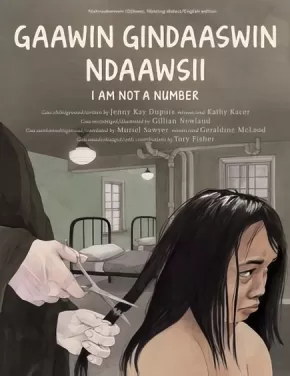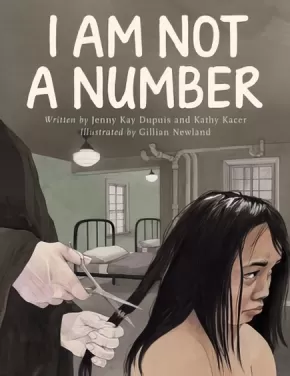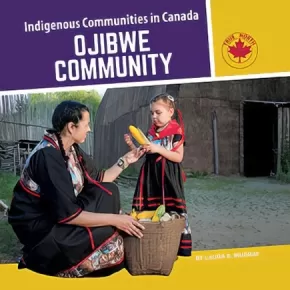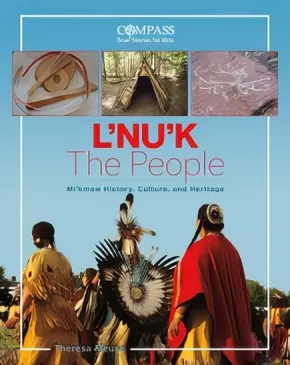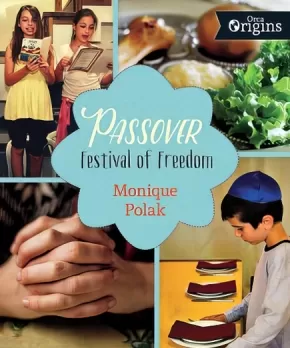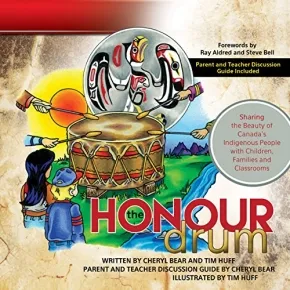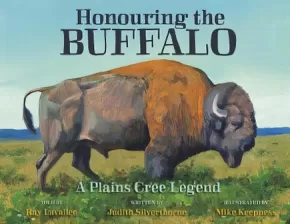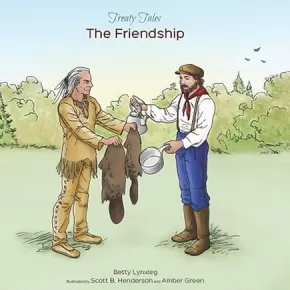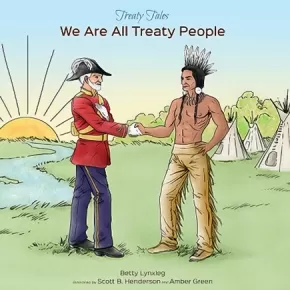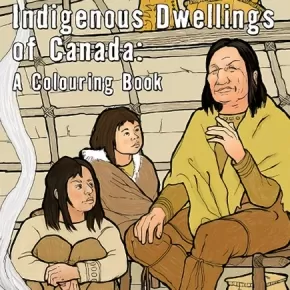
History
166
-
180
of
195 Results;
Sort By
Go To
of 13
Indigenous Communities in Canada: Mi'kmaq Community (3 in Stock)
$14.95
Format:
Paperback
Text Content Territories:
Indigenous Canadian; First Nations; Mi'kmaq;
ISBN / Barcode: 9781773081878
Synopsis:
Synopsis:
A book about the Mi'kmaq.
Educator & Series Information
This book is part of the Indigenous Communities in Canada series.
Additional Information
24 Pages
Speaking Our Truth: A Journey of Reconciliation
$29.95
Format:
Hardcover
Text Content Territories:
Indigenous Canadian;
ISBN / Barcode: 9781459815834
Synopsis:
Synopsis:
Canada's relationship with its Indigenous people has suffered as a result of both the residential school system and the lack of understanding of the historical and current impact of those schools. Healing and repairing that relationship requires education, awareness and increased understanding of the legacy and the impacts still being felt by Survivors and their families. Guided by acclaimed Indigenous author Monique Gray Smith, readers will learn about the lives of Survivors and listen to allies who are putting the findings of the Truth and Reconciliation Commission into action.
Educator Information
Recommended for grades 4 to 8.
A teacher guide for this resource is also available: Speaking Our Truth Teacher Guide
Additional Information
160 pages | 7.50" x 9.00"
Spirit Bear and Children Make History: Based on a True Story
$12.95
Artists:
Format:
Paperback
Text Content Territories:
Indigenous Canadian; First Nations;
ISBN / Barcode: 9781777009168
Synopsis:
Synopsis:
"Hello! My name is Sus Zul in the Carrier language. In English, people call me Spirit Bear. I am a proud member of the Carrier Sekani Tribal Council. I am on my way to Ottawa, Ontario, to witness a very important human rights case. Would you join me on this journey?"
When Spirit Bear's mom tells him about an important human rights case happening in Ottawa, Ontario, he makes the LONG trip (by train, his favourite way to travel) to go and watch, and to stand up for First Nations kids.
And he isn't the only one! Lots of children come too — to listen, and to show they care. Spirit Bear knows that children can change the world because he's there to see it happen.
This is the story of how kids — kids just like you — made a difference ... with a bit of help from some bears and other animals along the way!
Educator & Series Information
Spirit Bear and Children Make History tells the story of a landmark human rights case for First Nations children at the Canadian Human Rights Tribunal. Nine years after the case was filed, the Tribunal ruled that the government of Canada was racially discriminating against 165,000 First Nations children by underfunding child welfare and failing to provide equitable public services. The book contributes to the Indigenization of curriculum by centering the agency, histories and realities of First Nations children and communities. The story supports an Indigenous pedagogical approach by encouraging critical and independent thought. In keeping with Indigenous pedagogy, Spirit Bear teaches readers about Indigenous worldviews and values not through direct instruction, but through the modelling of ethical and respectful behaviour and action.
Spirit Bear and Children Make History addresses a gap in reconciliation education. There are few Canadian books for children linking reconciliation with social justice. Meaningful reconciliation in Canada requires the active engagement of children and youth. It also requires a critical and social justice approach that links the residential school system to contemporary inequities and discrimination. Educating children and families about contemporary inequities creates a foundation for change and challenges the myth that colonialism is a thing of the past.
Spirit Bear and Children Make History was written to engage a younger audience in learning about the child welfare case, and to demonstrate and affirm the powerful role of young people in the reconciliation movement. Inspired by the voices of children, and in keeping with to the Truth and Reconciliation Commission’s 94 Calls to Action, the story highlights the power of people of all ages and backgrounds to make a difference for First Nations children and families.
Recommended Grades: K-6
This book is part of the Spirit Bear series.
This book is available in French: Spirit Bear et les enfants passent à l’histoire: Basé sur une histoire vraie
Additional Information
54 pages | 8.25" x 8.25"
A Mishomis Book (Set of five coloring books)
$41.99
Artists:
Format:
Paperback
Text Content Territories:
Indigenous American; Native American; Anishinaabeg; Ojibwe (Chippewa);
ISBN / Barcode: 9781517901394
Synopsis:
Synopsis:
Who are the Ojibway people, and how did they come to live in the lands of the Great Lake? Let Mishomis, or “Grandfather” in the Ojibway language, draw you a picture. In these delightful coloring books, the history of the Ojibway unfolds, beginning with the story of creation.
As Original Man (some will call him Anishinabe) walks the Earth, giving names to all things, Mishomis carries young readers along with Ojibway lore and wonder and with pictures asking to be brought to colorful life. The story follows the first five books of The Mishomis Book, telling of the Original Man’s grandmother, Nokomis; of the Earth’s first people; and of the Great Flood that changed everything. Thank Gitchie Manito for Turtle, on whose back the new world rests! Coloring along with Mishomis’s words, readers will be enchanted to learn the legends and discover the spirit of the Ojibway traditions and way of life.
Educator Information
Recommended for grades 4 to 6.
This is a set of five coloring books that accompany the book The Mishomis Book: The Voice of the Ojibway (sold separately).
Additional Information
111 pages | 11.00" x 11.00"
Diwali: Festival of Lights
$24.95
Format:
Hardcover
ISBN / Barcode: 9781459810075
Synopsis:
Synopsis:
During Diwali, Hindus, Sikhs and Jains celebrate the legends and stories that describe the triumph of good over evil and justice over oppression. Critically acclaimed author Rina Singh explores her Indian roots as she tells the Diwali stories, which remind us that eventually light will prevail over darkness.
Enriched by personal stories and spiced with festive recipes, including two by acclaimed chef, Vikram Vij, Diwali: Festival of Lights brings to life the holiday’s traditions, food and rituals and takes you on a journey to see how this festival is celebrated around the world!
Diwali is the second book in the Orca Origins series, which examines how ancient traditions are kept alive in the modern world.
Reviews
"This sophisticated volume incorporates information about the major Indian religions; Hindu, Sikh, and Jain Diwali traditions; and Indian immigration to the U.S., Canada, and the Caribbean...An exceptionally valuable resource." — Kirkus Reviews
"A standout volume...an excellent introduction to Diwali and Indian culture, highly recommended for all geography collections." — School Library Journal
"Provides a remarkably comprehensive look at the origins of the Hindu festival of lights...The intimate tone and vibrant photographs make this book an enjoyable and informative read from start to finish. Young readers will love the photographs, and older ones will appreciate the joy and concept of a celebration of light." — Booklist
"Written in a very readable text accompanied by colourful historical and contemporary captioned photographs...This book would be a great compliment to a study of religious customs and multiculturalism...I would highly recommend it for inclusion in school and public libraries." — Resource Links
Educator & Series Information
This book is part of the Orca Origins series that explores cultural celebrations throughout the world.
Recommended for ages 9-12.
Additional Information
96 pages | 7.50" x 9.00"
Gaawin Gindaaswin Ndaawsii / I Am Not A Number
$14.95
Artists:
Format:
Paperback
Text Content Territories:
Indigenous Canadian; First Nations; Anishinaabeg; Ojibway;
ISBN / Barcode: 9781772600995
Synopsis:
Synopsis:
Dual language edition of powerful children's book about residential school experience reflects Indigenous language revitalization.
The dual language edition, in Nishnaabemwin (Ojibwe) Nbisiing dialect and English, of the award-winning I Am Not a Number. When eight-year-old Irene is removed from her First Nations family to live in a residential school she is confused, frightened, and terribly homesick. She tries to remember who she is and where she came from, despite the efforts of the nuns who are in charge at the school and who tell her that she is not to use her own name but instead use the number they have assigned to her. When she goes home for summer holidays, Irene's parents decide never to send her and her brothers away again. But where will they hide? And what will happen when her parents disobey the law? Based on the life of co-author Jenny Kay Dupuis’ grandmother, I Am Not a Number is a hugely necessary book that brings a terrible part of Canada’s history to light in a way that children can learn from and relate to.
Reviews
"Residential and boarding school stories are hard to read, but they're vitally important... books like I Am Not a Number should be taught in schools in Canada, and the U.S., too."— Debbie Reese, American Indians in Children's Literature
"It’s important to teach children about true Canadian history, but it’s not easy to talk about it in a way that children will understand. I Am Not a Number is perfect to get the conversation about residential schools started with your children. It opens the door for them to ask questions about the subject and the story is relatable in a way they can follow."— Residential School Magazine
Educator Information
Recommended Ages: 7-11
Guided Reading: V
Dual-language: Nishnaabemwin (Ojibwe) Nbisiing dialect and English.
Subjects: Character Education (Empathy, Prejudice & Tolerance); History & Social Studies (Canadian History, First Nations & Indigenous Peoples); Government & Citizenship; Reflecting Diversity
This resource is also available in English: I Am Not a Number.
This resource is also available in French: Je ne suis pas un numero.
Additional Information
44 pages | 8.50" x 11.00" | Translated by Muriel Sawyer and Geraldine McLeod with contributions by Tory Fisher
I Am Not a Number
$19.95
Artists:
Format:
Hardcover
Text Content Territories:
Indigenous Canadian; First Nations; Anishinaabeg; Ojibway;
ISBN / Barcode: 9781927583944
Synopsis:
Synopsis:
When eight-year-old Irene is removed from her First Nations family to live in a residential school she is confused, frightened, and terribly homesick. She tries to remember who she is and where she came from, despite the efforts of the nuns who are in charge at the school and who tell her that she is not to use her own name but instead use the number they have assigned to her. When she goes home for summer holidays, Irene's parents decide never to send her and her brothers away again. But where will they hide? And what will happen when her parents disobey the law? Based on the life of co-author Jenny Kay Dupuis’ grandmother, I Am Not a Number is a hugely necessary book that brings a terrible part of Canada’s history to light in a way that children can learn from and relate to.
Awards
- 2018 Red Cedar Award for Information Book Winner
- 2018 Hackmatack Award Winner
Reviews
"Residential and boarding school stories are hard to read, but they're vitally important... books like I Am Not a Number should be taught in schools in Canada, and the U.S., too."— Debbie Reese, American Indians in Children's Literature
"It’s important to teach children about true Canadian history, but it’s not easy to talk about it in a way that children will understand. I Am Not a Number is perfect to get the conversation about residential schools started with your children. It opens the door for them to ask questions about the subject and the story is relatable in a way they can follow."— Residential School Magazine
"[A] powerful teaching tool that brings a terrible part of Canada’s history to light in a way that children can learn from and relate to. It is written in simple language and told in a way that will stimulate conversations about residential schools and the traumatic effects they have had on generations of First Nation families and communities. ... beautifully illustrated by Gillian Newland. She captures the somber mood of the school, the anguish of the children, the severity of the nuns and the desperation of the family. Students can easily empathize with Irene and her brothers as well as their parents as they try to imagine how they would feel or act in a similar situation." — Alberta Native News, December 2016
"Endless cross-curricular connections can be made using this story. But the most powerful aspect of this book is that it will open a dialogue, one that Justice Murray Sinclair spoke of as head of the Truth and Reconciliation Commission, a dialogue that needs to take place for reconciliation to happen." — ETFO Voice
Educator Information
Recommended Ages: 7-11
Guided Reading: V
This resource is also available in a dual-language format (English and Nishnaabemwin (Ojibwe) Nbisiing dialect): Gaawin Gindaaswin Ndaawsii / I Am Not A Number.
This resource is also available in French: Je ne suis pas un numero
Additional Information
32 pages | 8.50" x 11.00"
Indigenous Communities in Canada: Ojibwe Community (3 in Stock)
$14.95
Format:
Paperback
Text Content Territories:
Indigenous Canadian; First Nations; Anishinaabeg; Ojibway;
ISBN / Barcode: 9781773080321
Synopsis:
Synopsis:
Ojibwe traditionally moved as the season changed but today many live across the country. Learn about Ojibwe traditional ways of life and how they respect their traditions in modern Canada.
Educator & Series Information
This book is part of the Indigenous Communities in Canada series.
Additional Information
24 Pages
L'nu'k: The People: Mi'kmaw History, Culture and Heritage
$19.95
Format:
Paperback
Text Content Territories:
Indigenous Canadian; First Nations; Mi'kmaq;
ISBN / Barcode: 9781771084529
Synopsis:
Synopsis:
The Mi'kmaq lived in Canada long before the country even got its name. Before Europeans arrived, they lived in homes called wigwams and hunted and fished throughout the Maritime provinces, living off and giving back to the land. They enjoyed storytelling, drumming, and dancing within their tightknit communities.
In L'nuk: the Mi'kmaq of Atlantic Canada, First Nations educator Theresa Meuse traces the incredible lineage of today's Mi'kmaq people, sharing the fascinating details behind their customs, traditions, and history. Discover the proper way to make Luski (Mi'kmaw bread), the technique required for intricate quillwork and canoebuilding, what happens at a powwow, and how North America earned its Aboriginal name, Turtle Island.
Educator Information
Includes informative sidebars, highlighted glossary terms, recommended reading, a historic timeline, index, and over 60 fullcolour historical and contemporary images.
Recommended for Grades 5-12 for these subject areas: Social Studies.
Additional Information
128 pages | 6.75" x 8.50"
Passover: Festival of Freedom
$24.95
Format:
Hardcover
ISBN / Barcode: 9781459809901
Synopsis:
Synopsis:
During Passover, Jews are reminded of how, more than three thousand years ago, their ancestors emerged from slavery to become free men and women. Bestselling author Monique Polak explores her own Jewish roots as she tells the Passover story, which reminds us that the freedom to be who we are and practice our religion, whatever it may be, is a great gift. It also teaches us that if we summon our courage and look out for each other, we can endure and overcome the most challenging circumstances. Enlivened by personal stories, Passover reminds us that we can all endure and overcome the most challenging circumstances.
Passover is the first in a series of books called Orca Origins that will examine ancient traditions kept alive in the modern world.
Reviews
"While this title in the Orca Origins series explains the holiday of Passover, it also goes further. In the introduction, Polak remembers her associations with the holiday while growing up in Montreal, mostly through friends’ seders...The sections in which the Holocaust survivors remember is both chilling and moving...Kids’ holiday rituals and personal stories make for an interesting mix. Illustrated with many color photos, this unique take on an ancient holiday should resonate with readers."— Booklist
"An overview of the holiday of Passover is elaborated with personal narratives, the story's connection to the Holocaust, and various Seder customs practiced in several countries around the world...A plethora of photographs, informational sidebars, drawings, and recipes break up the substantial yet enlightening text. Good supplementary material to increase the holiday's meaning and currency for older children."— Kirkus Reviews
"Each chapter is detailed with an abundance of information...Personal stories of Holocaust survivors, Ben and Liselotte, add to the appeal and authenticity of this title...A helpful glossary, and a list of references and resources are also included. Passover is the first in a series of books in the 'Orca Origins' series which will examine 'ancient traditions kept alive in the modern world.'"— CM Magazine
"The author does a thorough job of describing the origins of Passover, the intricacies of the seder, and the importance of this event to Jews around the world. She makes it all accessible to middle-grade readers, regardless of their ethnicity, by including the stories of specific individuals (including a couple of elderly Montrealers who survived the Holocaust), focusing on the participation of children in the seder, and including some simple recipes. The result is a lively read, illustrated with many photos."— The Montreal Gazette
"With her convivial, chatty writing style, the material is easily absorbed, and the richness of the culture and festival shine through. Facts are augmented and enriched by the narratives of many participants...Undoubtedly, the book will encourage much discussion and sharing of religious traditions and will be a welcome and highly readable addition to various library collections."— Canadian Children's Booknews
Educator & Series Information
This book is part of the Orca Origins series that explores cultural celebrations throughout the world.
Recommended for ages 9 to 12.
Additional Information
72 pages | 7.50" x 9.00"
The Honour Drum: Sharing the Beauty of Canada's Indigenous People with Children, Families and Classrooms
$12.95
Artists:
● Tim Huff
Format:
Paperback
Text Content Territories:
Indigenous Canadian;
ISBN / Barcode: 9781927355640
Synopsis:
Synopsis:
The Honour Drum is a uniquely envisioned and crafted project shared between two Canadian friends—an Indigenous woman from the West Coast and a non-Indigenous man from Ontario—to reach children, families and classrooms across Canada and around the world with a message of great beauty and truth that should not be ignored. This vibrant book is an important starting place for learning and insight that is vital and, for many people of all ages, overdue. The Honour Drum is a love letter to the Indigenous people of Canada and a humble bow to Indigenous cultures around the world.
Additional Information
42 pages | 8.50" x 8.50" | Paperback
Honouring the Buffalo: A Plains Cree Legend
$19.95
Artists:
Format:
Paperback
Text Content Territories:
Indigenous Canadian; First Nations; Cree (Nehiyawak); Plains Cree;
ISBN / Barcode: 9781927756331
Synopsis:
Synopsis:
"A long time ago, Our People came from the Northern Woodlands to the Great Plains looking for food," Grandfather said. "They saw that the Buffalo lived in harmony with Mother Earth the same as Our People did."
Through the Creator, the buffalo gave themselves as a gift for the sustenance and survival of the Plains Cree people. The largest land animal in North America once thundered across the Great Plains in numbers of 30 to 50 million. They provided shelter, food, clothing, tools, hunting gear, ceremonial objects and many other necessities for those who lived on the Plains.
But by 1889, just over a thousand buffalo remained, and the lives of the Plains Cree people changed. The buffalo is honoured to this day, a reminder of life in harmony with nature as it was once lived. This is the story of how the buffalo came to share themselves so freely.
Educator Information
The text is in English and y-dialect Plains Cree. Y-dialect Plains Cree translation by Randy Morin, Jean Okimasis, and Arok Wolvengrey.
This resource is also available in French: Hommage au bison.
Additional Information
48 pages | 11.00" x 8.50"
Treaty Tales: The Friendship
$19.95
Artists:
Format:
Hardcover
Text Content Territories:
Indigenous Canadian; First Nations;
ISBN / Barcode: 9781927849095
Synopsis:
Synopsis:
This beautifully illustrated children’s book is the second instalment of Treaty Tales, an original trilogy that makes learning about the treaties and their history fun and engaging.
When Neepin visits her kookoo to make homemade bannock, she learns about an important friendship that started a long time ago and still lasts today.
Educator Information
This resource is part of the Treaty Tales Series.
This resource is also available in French: L’amitié
Additional Information
30 pages | 10.23" x 9.25"
Treaty Tales: We Are All Treaty People
$19.95
Artists:
Format:
Hardcover
Text Content Territories:
Indigenous Canadian; First Nations;
ISBN / Barcode: 9781927849149
Synopsis:
Synopsis:
This beautifully illustrated children’s book is the third and final instalment of Treaty Tales, an original trilogy that makes learning about the treaties and their history fun and engaging.
Join Neepin and her kookoo around the campfire in We Are All Treaty People, and hear a story about the modern-day significance of the treaties for all those living in Canada. Maybe even become inspired, like Neepin, to take up the First Nations storytelling tradition.
Educator & Series Information
This book is part of the Treaty Tales series.
This resource is also available in French: Les traités nous concernent tous
Indigenous Dwellings of Canada: A Colouring Book
$6.95
Artists:
Format:
Paperback
Text Content Territories:
Indigenous Canadian;
Synopsis:
Get ready to have fun and learn at the same time! Explore the many different homes and cultures of Turtle Island’s nations, past and present, throughout Indigenous Dwellings of Canada.
Each beautiful, black-line illustration includes carefully researched commentaries by Katherine and Leo Pettipas. Not only do they tell fun stories, but offer informative glimpses into Canadian history.
This educational colouring book is full of images and tales that will delight students and artists of all ages.
Sort By
Go To
of 13

